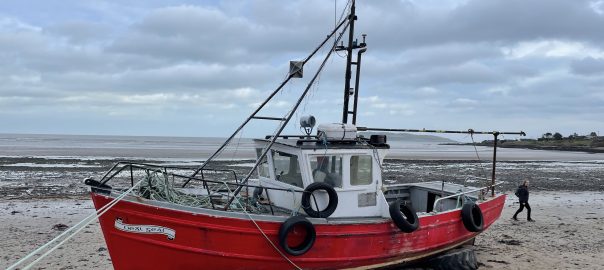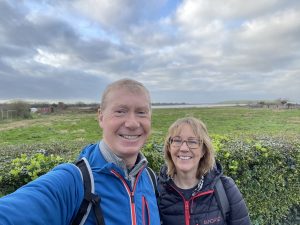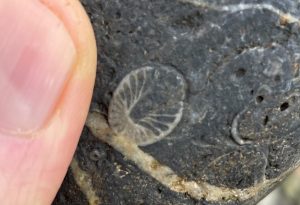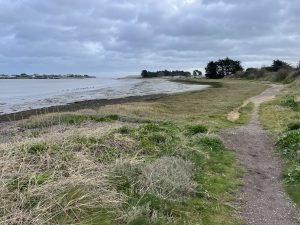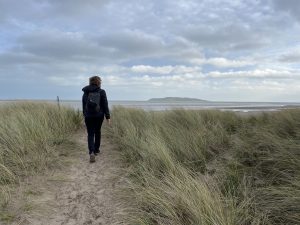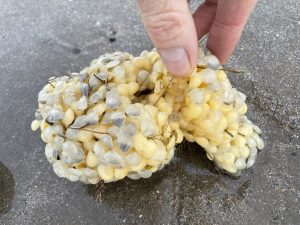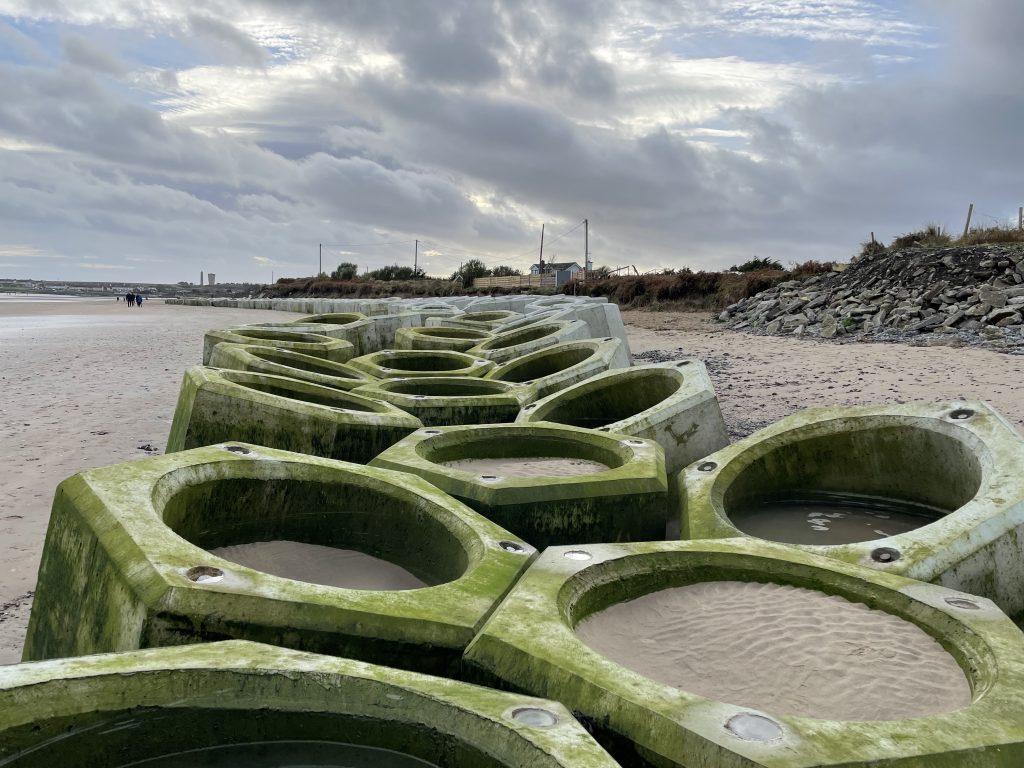Ireland day 0094. Friday 31 December 2021- Burrow
| Today’s summary | Took the train to Donabate then the 33B bus up into the Burrow peninsula. Walked round the north of the peninsula then back down the east coast to Donabate Beach via Portrane then along the road back to the station. No specific New years Eve plans | ||||
| Today’s weather | Very mild and dry all day. Quite bright and a glimpse of sun late afternoon. Moderate south westerly breeze on the beach. About 14C | ||||
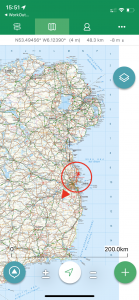 |
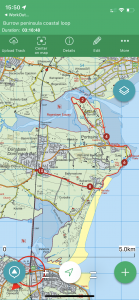 |
||||
| Today’s overview location (the red cross in a circle shows where Val and I are at the moment) |
Close-up location (Click button below to download a GPX of our walk this afternoon): Burrow peninsula walk |
||||
Commentary
Every time we head off to explore a new bit of the Irish East coast, I think that there can’t possibly be any more big, wide, sandy beaches to discover. But each time I am wrong, and today was no exception.
While we are waiting to sort the car situation out, we’re making full use of public transport to see as much as we can of the area around Malahide. The coast is an obvious destination, as it’s mostly pretty easy to get to, and because once you get there, you have freedom to walk where you want, and uplifting panoramas to enjoy, both out to see and forward to the landward horizon.
A couple of weeks ago, we had taken the train one stop up the line to Donabate and tried to walk north to the coast along the southern shore of the Rogerstown estuary. But we had got stuck when the path was fenced off by private property – though the bonus side effect was that we discovered a castle and a bakery. But this still left a large chunk of the peninsula to the north of Donabate (locally known as the Burrow peninsula) unexplored, so today we decided to make a bit more determined effort to get up there and see if there really were dragons in this bit of Irish terra incognita.
We set out by repeating our one-stop train hop across the Broadmeadow estuary to Donabate and from there took the 33B bus (yes I know it does sound like a bra size so feel free to chortle childishly) to the end of the route at Marsh Lane. The north western reaches of the Burrow peninsula are beautifully quiet, with just a few houses and a pebbly shore which nobody really ever seems to visit. So for an all-too-brief moment, it was just us, with the gentle wind, a few waves lapping on the shore and the cry of the oystercatchers to accompany us on our walk.
We successfully rounded the top of the headland – aided by a rapidly ebbing tide which exposed flat sand for walking – and then headed back down the east side all the way to Portrane. The eastern beach is what I am now beginning to realise is a “classic” Irish east coast beach – vast flat expanses of sand which get even bigger when the tide goes out – and a fascinating array of stranded flotsam and jetsam to inspect as you plod along. We had lunch among the rockpools near Portrane and had in fact intended to get the bus back from there. But we were enjoying the walk so much – helped no doubt by the record-breaking high temperatures – that we decided to press on past the Martello Tower, then across Tower Bay beach and down the rocky shoreline to Donabate Beach.
Sadly Donabate beach isn’t actually in Donabate, and there’s no bus service from there, so, much like the walk back from Rush, we had to hot-foot it back down the road to the station. But Donabate Beach does have the added attraction of a nice hotel serving tea and coffee from an Airstream in the car park – a facility that seemed extra popular today as hundreds of new years eve visitors had flocked to the beach to make the most of 2021’s last gasp.
By the way – you may have noticed quite a few estuaries – Rogerstown and Broadmeadow to name but two – have featured in today’s blog. That’s because the east coast between Dundalk and Dublin is largely flat and sandy and outflowing rivers quickly erode broad, shallow tidal lagoons as they approach the sea. Erosion is an issue all the way up and down the coast in fact, and is why the shores at Rogerstown and Portrane are decaying so fast. My theory is that the silt cut away by the sea is transported by a southerly drift and ends up getting deposited at points further down the coast. That would explain why the coasts to the north are shrinking, whereas those to the south – like Bull Island – are expanding. And what’s more the Irish word for “estuary” is “inbhear” (pronounced “inver”). I guess the Scottish town of Inverness got its name from a similar Scots Gaelic root – “Estuary of the river Ness”.
And on that note, I think it’s time to say goodbye to 2021. It hasn’t really turned out as most of us had expected – or perhaps hoped – but I hope it’s been as interesting and rewarding for you as it has for us. Let’s all look forward to 2022, and vow to make the very best of whatever surprises it serves up for us. Until then:
“athbhliain faoi mhaise duit!”
Today’s photos (click to enlarge)
